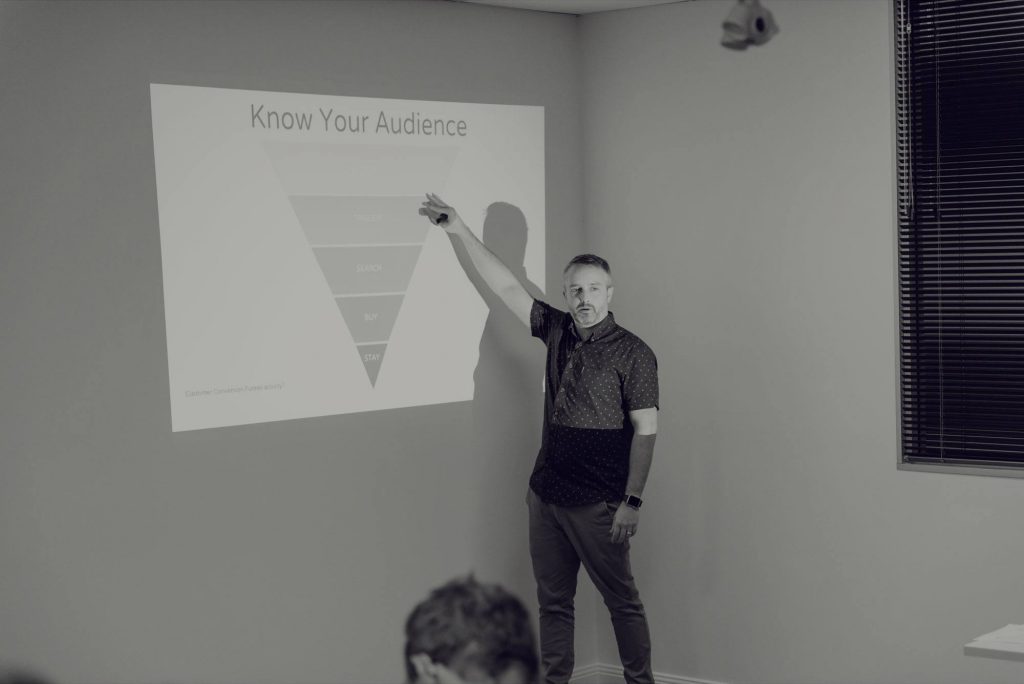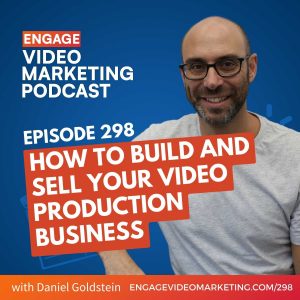… or avoiding the curse of Tacticitus.
“If I put the video on YouTube and stick it on my website then I can share the link to Facebook and send it out to my email list and share it to LinkedIn and tell my Mum to send it to all her friends and copy the link into all the Facebook groups I’m in and put a QR code on my business cards and boost the post so I get more views and maybe even do a YouTube ad and add the video thumbnail to Instagram and…”
Yep. A relatively common stream of consciousness I encounter when working with enthusiastic, well-meaning and somewhat confused clients looking to reach more people with their online video content. Can you see the problem here? It’s all about perspective, and a failure to see the wood for the trees.
The digital marketing landscape is now more accessible than ever whilst also being more complex. The array of choice a business owner or marketer has when it comes to which platform to use, in what way and how often provides countless powerful tools at our fingertips but at the same time opens up so many more ways to make mistakes, get lost in confusion and result in overwhelm and inaction. More commonly, what I see is business owners becoming too bogged down in understanding the in’s and out’s of how a particular platform works, self-educating and scurrying to keep up in an attempt to keep themselves relevant and enquiries coming in.
The Curse of Tacticitus
The sad truth is that these businesses are suffering from a common ailment I refer to as ‘Tacticitus’ – the unfortunate state in digital marketing in which one is seemingly stuck in the implementation and optimisation of activities on a variety of digital tools and platforms but is unable to step back and evaluate the overall goals or strategy for said activities.
Jokes, and ailment metaphors aside; this really is the number one mistake that I see business owners make when considering their online video marketing. With no clear idea of the strategy, they are simply implementing tactic after tactic, and often with little or unsatisfactory results. With no strategy (or map) you’re blindly pushing forward down unmarked trails, taking twists and turns (the tactics) which will ultimately get you lost.
Brian Tracey said it very well,
“A genius without a roadmap will get lost in any country”.
The Roadmap for Your Video Marketing
The idea of designing a roadmap or strategy for your business is certainly not a foreign concept to most however it’s often quite overlooked when it comes to the use of digital and social media platforms. This is likely to do with the fact that most businesses find themselves dabbling with social media or digital in the early days and tactic after tactic they being implementing various things online (some successful, others not) but with no real ‘bigger picture’ thought put into how they are approaching their digital marketing.
It might start with some Facebook page updates, or a blog post was written here and there, perhaps they find themselves with an email list and are encouraged to start sending out ‘news’ to their customer base. Perhaps in some cases, it’s a younger staff member, intern, son or daughter who drives the business onto digital platforms. In all cases, no matter how or why the digital ‘Tacticitus’ has begun to set in it is not too late to start treatment by developing a documented strategy for your online video and digital marketing.
Recently, I sat down to consult with a new client and help them do just that. They recognised from the outset that their current marketing (online and offline) lacked consistency, had no real sense of their brand, and to be honest – just wasn’t working very well. I coached them through the 4 steps process of pulling things back to;
- Gain real clarity on what it is they wanted to achieve
- Identifying who they were wanting to serve in their business
- Working out how that audience could be reached and
- How they would be best placed to measure the success of their strategy moving forward.
As we worked through the process I could visibly see the clients shift from focussed attention to excited nods as it highlighted for them all those things that they were already doing well, and made it clear to them those things that were a waste of time and money.
4 Steps for an Effective Online Video Strategy
Developing a video marketing strategy, at a core level, is simply these 4 steps. Let me simplify and break them down for you a bit further.
Step 1: Set Your Goals
Any marketing activity should be clearly aligned with the overall goals for your business. It is critical in developing a strategy that this is where you start. One great way to look at this is to consider your one big business goal (I like to refer to this as your BHAG – Big Hairy Audacious Goal). This might be a business growth goal, a revenue goal, an influence goal or something else that will really shift the needle for you and your business.
From that One Thing, you should then be able to break down your top three marketing goals that will help you achieve the one big goal. Often I’ll simplify these three marketing goals into;
- Increase brand awareness
- Drive more engagement
- Convert more sales
Now, as you identify and clarify your top three marketing goals you may realise that your business is already stronger in one area more than another. This realisation will help direct your marketing strategy into the areas and goals that require the most attention. Critically, as we move through the next three steps in your strategy you’ll be able to directly refer back to your goals ensuring that the decisions you make align with your goals and ultimately your one big goal.
Step 2: Identify Your Audience
With your goals sorted, now you need to be clear on who it is that is going to help you get there. That is, who is your audience? Are you targeting the right market to reach your goals? Do you know your audience (or target market) better than they know themselves?

My favourite method to get clarity on your target market is to create a small number of (no more than 3 or 4) detailed customer avatars. (A full rundown on how to do this, including resources can be found in my free ‘Foundations’ video course). In short, your customer avatars is a document describing the ideal customer you wish to serve. The avatar should describe an individual, not a generic demographic such as Males aged 30 – 65. In general, your avatars should detail the following;
- Give the client a name
- Demographic information (gender, age, location, income, employment etc)
- Psychographic information (dreams, fears, desires etc)
- Habits & processes (what technology they use, platforms they’re on, how they behave etc)
- How your business helps them & solves their problems
When you’re clear on who your business serves and you understand their fears, desires, motivations and actions that lead them to buy from you, this is a seriously powerful tool at your marketing disposal.
Step 3: Design Your Content Plan
The content you produce, and what you do with it should always be directly informed by the first two steps in your strategy design. Too often I see businesses creating content with little thought to strategy and then simply uploading it or embedding it where ever and whenever they can. This is so much more than putting the cart before the horse! In my mind, this is like milling the timber, building the cart, loading the cart up with everything you own and then realising you don’t even have a horse!
As you design your content plan you need to be constantly referring back to your defined goals and the insights you now have into who you’re communicating with. With that in mind, there are two main considerations to factor into your video content plan;
- Content
What your video(s) will be about, the style of production, duration, structure, methods of production and so on. - Distribution
What platforms will the content be shared on, networks to leverage, and your promotion and amplification strategy?
Importantly, for a truly effective online video strategy, these two should be dynamically linked when it comes to the resulting content produced under your strategy. That is, the style, type, durations and production of the piece of content should be relevant to the intended distribution plan for the content.
Let me explain.
Let’s say that based on a specific goal and a clear idea of who your audience is for a particular piece of content, it is decided that the distribution plan for the content will focus on the Instagram video platform. Your video content, therefore, should be produced natively for that platform. So, you’ll be wanting to create a predominantly visual piece, in a square (1:1) aspect ratio, that is shorter than 60 seconds. Equally, if your strategy requires the production of content that is heavily educational, and goes in-depth in a long form video training style then you’ll be wanting the distribution of that content to be primarily focussed on YouTube, Wistia or perhaps a Webinar Platform.
Step 4: Measure & Analyse
Now, with your goals clear, your audience outlined and your content and distribution strategy documented there is one last important step that will help determine once and for all if the decisions you made in the first three steps were even the right ones in the first place. You need to understand how you’re going to measure the success of your strategy against your goals.
Management guru Peter Drucker is quoted as saying, “You can’t manage what you don’t measure.” and this is exactly what we’ll be aiming to achieve with this step. Managing and determining the success of your strategy comes down to an understanding of two key elements;
- Metrics
- Analysis
In order to determine whether your strategy scored or not you need to first be clear on where the goal posts are. Both a benefit and a challenge in video and digital marketing is the sheer amount of varying metrics that can be gathered around your content online. In social video campaigns, you can measure everything from views, clicks and viewer retention through to playback locations, ad revenue, viewer geographical data and everything in between. The importance of identifying the ‘metrics that matter’ for each particular campaign comes back, once again, to the goal, audience and content plan already established.
Quite simply, if your goal for the content was to increase brand awareness within a particular market demographic then the metrics to pay attention to should be based on the number of the ‘right eyeballs’ that viewed your content. However, if your goal was to convert more online shop visitors into purchasers of a particular sale item then the video metrics to pay attention to should be click-throughs and $ value sold.
Then, with a clear idea of the metrics, you’ll be giving weight to when it comes to each piece of video content or campaign, you’ll be able to now do a valuable analysis of the data that is available to you. You’ll be able to look for indicators such as how engaging was the content for the target audience or how compelling was the call to action in increasing sales volume.
Avoiding the Avalanche of Average
The reality is for many in business and marketing applying at least a cursory approach to developing a strategy such as this behind an online video campaign will catapult them ahead of a majority of their competition using the medium. And as we see more and more online video and digital content piling up around us across our digital landscape it becomes even more important to be a step ahead in our content game and avoid adding to the avalanche of average content.
At it’s simplest form I see online video content as simply one of the ingredients in an effective marketing plan. The strategy then can be seen as the recipe, which is so important in bringing the ingredients together in the right way for a tasty outcome.
By following the four steps outlined above, and mapping out your online video strategy thoughtfully before you roll camera you’ll be confident in creating an effective strategy to reach your intended goals, and hopefully stay well clear of the dreaded ‘Tacticitus’. More importantly, however, this is how to design marketing that shifts the needle and returns on your investment of time and money. It’s not an exact science, but a proven process that when combined with some trial, error and thoughtful implementation will have you feeling more in control and purposeful with your video marketing.
—–
Building your Online Video Strategy ‘Foundations’
To get started the right way developing a detailed and effective online video strategy let me walk you through it with my free 3 part video course ‘Foundations – by Engage Video Marketing’. Click here for instant access to get started.



